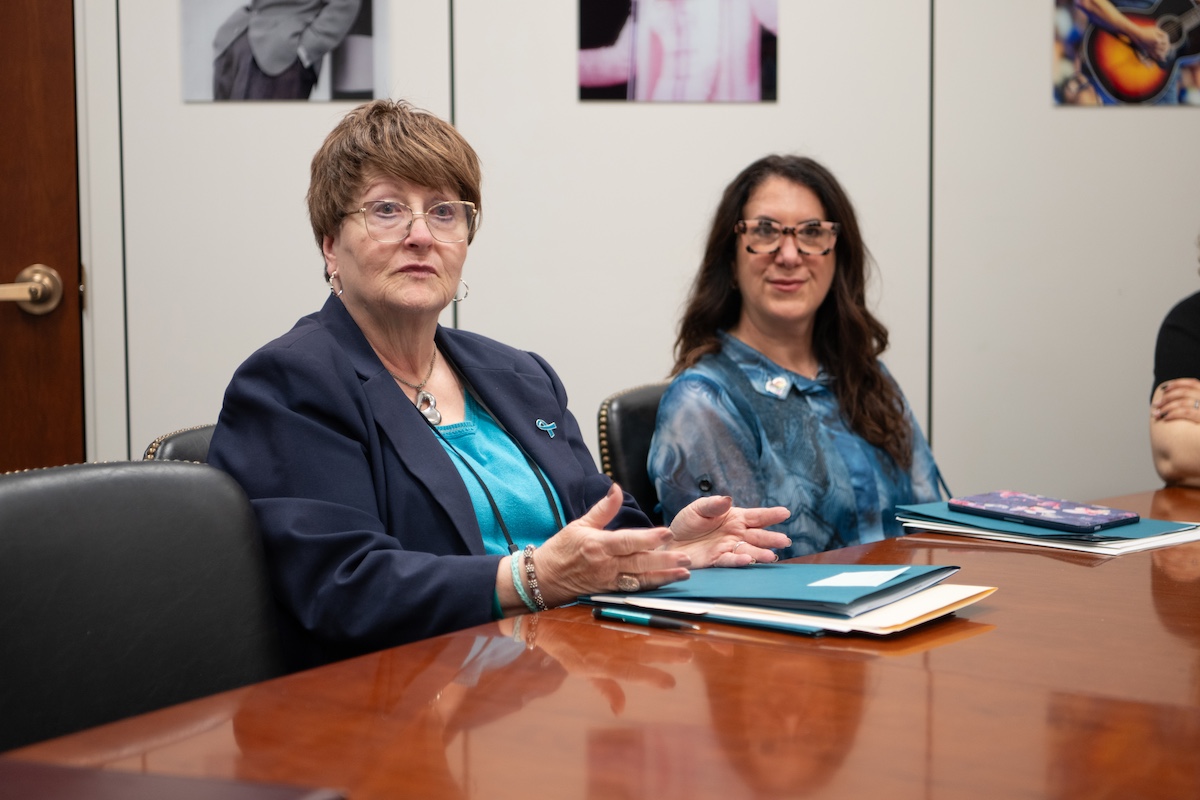Ovarian cancer survivor Susan Leighton reports on her experience at the American Association of Cancer Researchers meeting, which took place in April 2013.
For the second year in a row I had the privilege of being selected to attend the Scientist-Survivor Program (SSP) of the American Association of Cancer Researchers. The SSP program was established to build partnerships among the leaders of the scientific community and the cancer survivor and patient advocacy communities. Through this program, advocates attend special lectures to help them to better understand the science presented at the annual meeting. Advocates participate in discussions and a group project designed to help them focus on and navigate the research presented throughout the week. The Ovarian Cancer National Alliance (OCNA) is my dissemination partner for this program, and is helping me share information from the conference with the ovarian cancer community.
I have attended various conferences over the past few years. It often seemed to me that there were far too few sessions and posters about ovarian cancer; however, in the last two years I have seen more and more being done in the field. I have also learned to recognize research of a more general nature that has potential impact on ovarian cancer. I no longer walk by posters that address solid tumors and do not state “ovarian cancer” specifically. Pathways discovered in one solid tumor may be applicable to another, including ovarian cancer. The special interest sessions hosted for the SSP participants has greatly increased my understanding of what might be applicable for our community.
This year much press was given to a presentation given by Dr. George Coukos from the University of Pennsylvania and a poster presented by lead study author, Dr. Lana Kandalaft. I attended Dr. Coukos’ Meet the Expert Session and viewed the poster. The lead in on the CBS national news the opening night of the AACR conference was “Ovarian Cancer Vaccine Gives Patients Hope.” I was anxious to hear if the results were as exciting as the headline had made them out to be. The short answer is, yes and no. This is progress but not yet a cure. At the conclusion of a phase I trial, one woman had achieved complete remission and seven other women had no measurable disease. I had read information on previous vaccine trials and they had shown mixed results, certainly nothing as exciting as this.
What made this time different? Throughout the AACR conference this year a recurring theme was tumor microenvironment; it was evident that the microenvironment plays a key role in the potential effectiveness of these vaccines. The vaccines were created from the individual’s tumor and blood as had been done previously. In this research, however, an additional step has been added. In a large percentage of ovarian cancer tumors regulatory T cells (Treg) cells are present intratumorally. Treg cells are the cells in the immune system that modulate the immune system’s response. Women with Treg cells in the microenvironment had a greater response with the vaccines. Researchers are now capitalizing on the Treg feature: removing these cells from the blood, stimulating and expanding the cells in the laboratory and re-injecting them into the patients given the vaccine. Results are showing great promise as clinical trials continue. Patients were also given bevacizumab while receiving the vaccine. Side effects were mild. This is not yet a cure, but definitely hopeful.
While there were very few sessions at the AACR conference dealing specifically with ovarian cancer, there were a number of posters on the subject. Two studies of interest investigated epidemiological factors of diet and water intake.
- Differences in ovarian cancer incidence rates worldwide suggest an important role for lifestyle factors, including diet, as influencing disease risk. The research suggested that higher intake of omega-3 may be protective for ovarian cancer while high consumption of trans-fats appears to increase the risk. Additional studies are needed. [1]
- Dietary nitrate or nitrite intake was not associated with ovarian cancer risk. The researchers’ findings suggested that nitrate intake from drinking water may increase ovarian cancer risk, particularly in the likely presence of other contaminants found in surface water. Further evaluation of water contaminant levels of various contaminants on ovarian cancer risk in this population is warranted.[2]
Other posters of interest to the ovarian cancer community were:
- A widely accepted hypothesis for the beginning of ovarian cancer is frequency of ovulation. Long-term administration of oral contraceptives interrupts the ovulatory cycle and reduces risk of ovarian cancer. In order to prove or disprove this hypothesis, the authors looked at several algorithms used to calculate “Lifetime Ovulatory Cycles”(LOC), which took into account age at menarche, age at menopause, time pregnant, time breastfeeding, oral contraceptive use and other periods of amenorrhea. Increased LOC values were associated with increased risk of ovarian and endometrial cancers. The researchers concluded that LOC algorithms could be formulated based on widely available variables and could be used to assess risk.[3]
- This researcher sought to understand the dynamics of peritoneal metastases. Ovarian cancer recurs as it originally presents, with growths within the peritoneal cavity. Some cells are anchorage-independent, which means they do not require a solid surface on which to grow. These cells can migrate and form metastases. Understanding this process would provide significance for treatment of recurrent disease. The research led to characterization of an in-vitro model of recurrent, treatment-resistant serous ovarian cancer cells with the ability to gather in two types of clusters that survive in an anchorage-independent manner. The spontaneous development of these clusters (aggregates and spheroids) at recurrence may represent a preclinical model to study the disease malignancy and ways to interrupt progression.[4]
- Researchers studied the effectiveness of Pantethine (a form of pantetheine, a derivative of vitamin B5). The study concluded that pantethine is a promising new drug against ovarian cancer showing effects on tumor progression, metastases occurrence and ascites formation.[5]
- The tumor suppressor p53 gene is the most frequently mutated gene in high-grade serous ovarian cancer, the deadliest subtype responsible for 70% of ovarian cancer deaths. The exact role of this gene mutation is unknown. This research suggests that the p53 mutation plays a tumor-initiating role as well as a role in progress of ovarian cancer.[6].
There were several posters looking at biomarkers for ovarian cancer whether diagnostic (identifying the disease), prognostic (projecting how well a patient will do) or predictive (how well a patient will respond to a certain treatment).
- Elafin, a proteinase inhibitor found on a chromosome, is overexpressed by high grade serous carcinoma of the ovary and is associated with poor overall survival and chemotherapy resistance (prognostic biomarker). This research looked at the similarities in Elafin expression in high grade serious ovarian cancer and basal-like breast cancer. The conclusion was that Elafin is a potential prognostic biomarker for both diseases.[7]
- Two things make epithelial ovarian cancer (EOC) the leading cause of gynecologic cancer death in the United States: late diagnosis and early recurrence. Proganulin (PGRN) is a growth and survival factor overexpressed in EOC. These researchers hypothesized that elevated serum PGRN levels after complete clinical response to platinum and taxane-based chemotherapy prognosticates disease recurrence and decreased survival in advanced EOC. Results of the study bore this out and further study of PGRN values could lead to its potential as a prognostic biomarker to identify those at high risk of recurrence. Such a prognostic biomarker could identify those women who should be monitored closely or potentially placed on maintenance chemotherapy.[8]
One session which applied to several cancers focused on the microenvironment of the tumor, which offers many potential targets for treatment and for biomarkers. Research presented by Dr. Michael Gordon Research Director for Pinnacle Oncology/Hematology in Arizona described the engineered antibody MPDL3280A, which targets a protein called programmed death-ligand 1 (PD-L1). The PD-L1 antibody has been effective for several cancers including lung, kidney, colon and stomach and was well tolerated. Those patient who responded to it, continue to respond. These are all solid tumors, as is ovarian cancer. Other immunotherapy antibodies that target this family of molecules are in development. There were several presentations about the PD-1 and PD-L1 ligand. While this is still in phase I trial, this research opens research into a new potential target.
The closing night of the AACR Conference the survivors gathered to celebrate completing the SSP program. While we were exhausted from walking the halls of the convention center and our brains were numb from all the information we had absorbed or at least tried to absorb, we were challenged by Dr. Anna Barker, the Director and Founder of the SSP program, to take what we learned and share it with our communities. She also challenged us to use our advocate armies to make a difference in the way research is done, specifically asking us to take on the project of biospecimens and repositories. I left feeling empowered by information and inspired to help move the science forward.
[1] “Dietary fat intake and risk of epithelial ovarian cancer by tumor histology,” Melissa A. Merritt, Daniel W. Cramer, Allison F. Vitonis2, Stacey A. Missmer, Linda J. Titus, Kathryn L. Terry. Department of Epidemiology, Harvard School of Public Health, Boston, MA; OB/GYN Epidemiology Center, Brigham and Women’s Hospital, Harvard Medical School, Boston, MA; Division of Reproductive Medicine, Department of Obstetrics, Gynecology, and Reproductive Biology, Brigham and Women’s Hospital and Harvard Medical School, Boston, MA; Department of Community and Family Medicine, Dartmouth Medical School, Hanover, NH.
[2] “Dietary intake of nitrate and nitrite, nitrate in drinking water, and ovarian cancer risk among postmenopausal women in Iowa.” Maki Inoue-Choi, Kristin E. Anderson, James R. Cerhan, Peter J. Weyer3, Mary H. Ward4. 1University of Minnesota, Minneapolis, MN; 2Mayo Clinic, Rochester, MN; University of Iowa, Coraville, IA; National Cancer Institute, Bethesda, MD.
[3] “Lifetime ovulatory cycles and risk of ovarian and endometrial cancers.” Hannah P. Yang, Kelsey Murphy, Neena George, Montserrat Garcia-Closas, Jolanta Lissowska, Louise A. Brinton, Nicolas Wentzensen. National Cancer Institute, Rockville, MD; Drexel University, Philadelphia, PA; Institute of Cancer Research, United Kingdom; M. Sklodowska-Curie Cancer Center, Poland.
[4] “High grade serous ovarian cancer cells spontaneously self-organize in vitro into multicellular irregular aggregates and highly organized spheroids” Alicia A. Goyeneche. University of South Dakota School of Medicine, Vermillion, SD.
[5] “Pantethine, a new therapeutic approach against ovarian cancer.” Marie-France Penet, Silvana Canevari, Franca Podo, Max de Reggi, Bouchra Gharib, Zaver M. Bhujwalla. JHU ICMIC Program, Division of Cancer Imaging Research, Russell H. Morgan Department of Radiology and Radiological Science, The Johns Hopkins University School of Medicine, Baltimore, MD; Unit of Molecular Therapies, Department of Experimental Oncology and Molecular Medicine, Fondazione IRCCS Istituto Nazionale dei Tumori, Milan, Italy; Department of Cell Biology and Neurosciences, Section of Molecular and Cellular Imaging, Istituto Superiore di Sanità, Rome, Italy; Neurobiology of Cellular Interactions and Neuropathophysiology, UMR CNRS 7259, Aix-Marseille University, Marseille, France.
[6] “A p53 activating mutation accelerates the progression of high-grade serous ovarian cancer arising from the fallopian tube.” Jaeyeon Kim1, Donna M. Coffey2, Lang Ma1, Martin M. Matzuk1. 1Baylor College of Medicine, Houston, TX; 2The Methodist Hospital and Weill Medical College of Cornell University, Houston, TX
[7] “Elafin is a candidate biomarker that underlies the similarities between basal-like breast cancer and ovarian cancer” Intidhar Labidi-Galy, Adam Clauss, Vivian Ng, Sekhar Duraisamy, Shridar Ganesan, Ronny Drapkin. Dana Farber Cancer Iinstitute, Boston, MA; Dana Farber Cancer Institute, Boston, MA; Cancer Institute of New Jersey, New Brunswick, NJ.
[8] “Progranulin as a prognostic biomarker of advanced epithelial ovarian cancer” Sharon Fitzgerald1, Minshu Yu, John Hays, Nicola Di Santo, Laura Havrilesky, Elise Kohn. Walter Reed National Military Medical Center, Bethesda, MD; National Cancer Institute, Bethesda, MD; 3Duke University, Durham, NC.


